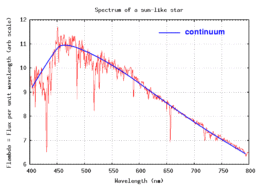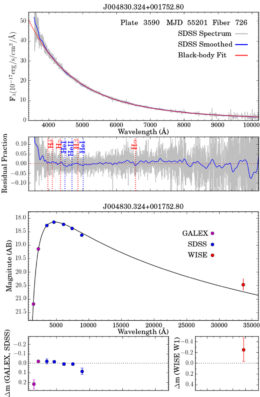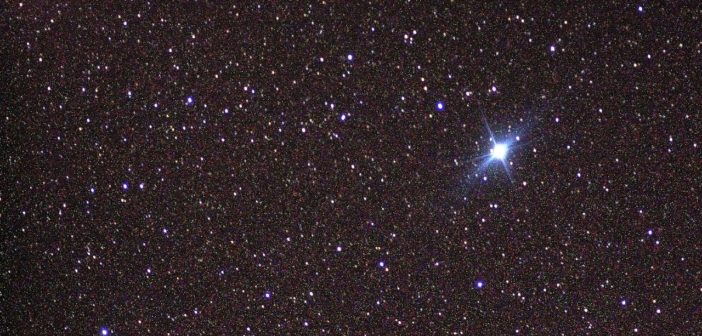Let’s be honest: nature is messy. Natural forms are complex, and simple models are just approximations — there are no truly spherical cows. And yet … it seems there might actually be some true blackbody stars.
Messy Spectra
Just like you can approximate a complex 3D shape — like a cow — by modeling it as a sphere, stars and planets can be simply approximated by modeling them as perfect blackbodies. Blackbodies are objects that absorb all radiation that shines on them, and they emit their own radiation with a characteristic spectrum that depends only on temperature and spans all electromagnetic wavelengths.

This spectrum of a solar-like star shows just how far a typical star’s spectrum (red) deviates from the ideal blackbody (blue). [Michael Richmond]
Sometimes, however, nature apparently is simple. Two scientists, Nao Suzuki and Masataka Fukugita of the University of Tokyo, have now discovered 17 stars that are ideal blackbodies: the stars have no distinct spectral features from infrared to ultraviolet wavelengths.
The Hunt for No Features
The first of these bizarre stars was found by accident — it was stumbled upon in a Sloan Digital Sky Survey (SDSS) catalog of quasars. Following up on this unexpected discovery, Suzuki and Fukugita hunted through nearly 800,000 star-like objects in SDSS archives, looking for other blackbody spectra that showed large proper motions (implying the objects are probably nearby stars) and no spectral features.

Example of data and residuals for one of the authors’ blackbody stars. The top panel shows the observed spectrum (grey), the spectrum with noise smoothed (blue), and the blackbody fit (red). The bottom panel shows the photometric data from which the fit parameters are derived. [Suzuki & Fukugita 2018]
The 17 blackbody stars pose an intriguing puzzle: what are these oddly ideal bodies? Suzuki and Fukugita argue that the stars’ properties are consistent with those of a special type of compact object — a DB white dwarf — that has a temperature too low (a cool ~10,000 K) to develop helium absorption features.
Time to Calibrate
What can we do with these objects? When nature hands you a beautifully perfect blackbody spectrum, there’s clearly only one course of action: use it to calibrate all your instruments!
Suzuki and Fukugita used their blackbody stars to carefully examine the zero point that was set for each of SDSS’s five photometry passbands, as well as the consistency of these zero points with those of the ultraviolet photometry for GALEX and the infrared photometry for WISE.
Just like that, a simple model proves unexpectedly relevant — and spherical-cow stars provide a useful calibration measure for current and future instruments. If only all of nature were so kind!
Citation
“Blackbody Stars,” Nao Suzuki and Masataka Fukugita 2018 AJ 156 219. doi:10.3847/1538-3881/aac88b


1 Comment
Pingback: AAS Nova – New